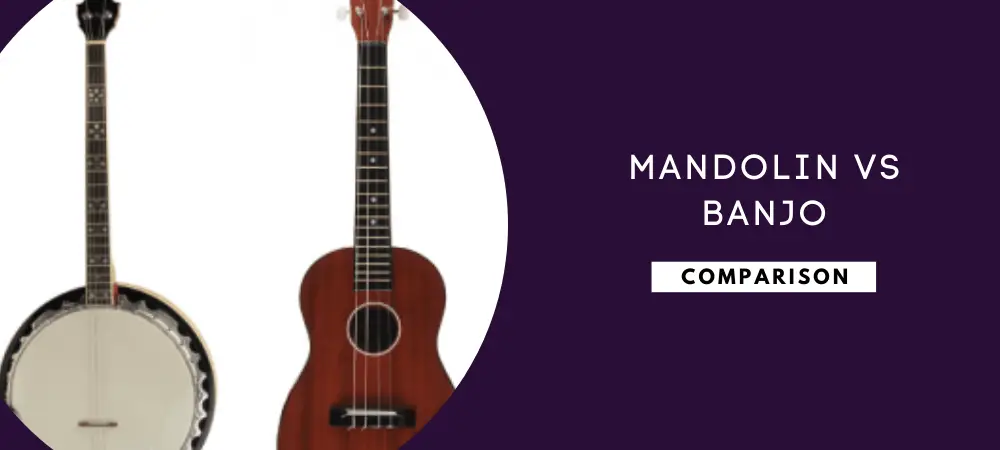The mandolin and the banjo might be noticeably different in many ways, but they share a lot of similarities, as well.
Therefore, if you find both of them fascinating and can’t seem to decide which one to learn first, you’re reading the correct article.
Without wasting time, let’s dig deeper into their differences to help you decide which one to choose:
Table of Contents
Mandolin vs Banjo: Comparison Table
|
Instrument |
Banjo | Mandolin |
| Strings | 4-5 | 8 |
| Size | Long neck, big | Small neck, tiny |
| Tuning | Fifths, traditional tuning of DGBD | Fifths |
| Price | From $200 and $500-$700 decent instrument | From $300-$400 decent playable instrument |
| Portability | Bulky | Light weight |
|
Difficulty |
Not too easy |
Easy |
The Differences Between Mandolin vs Banjo
Strings
One of the significant differences between the mandolin and the banjo is the strings on each instrument.
For instance, the mandolins come with eight strings, which are tuned in pairs and tuned in unison to guarantee sound consistency.
On the other hand, most banjos come with either 4 or 5 strings, with the 4-string banjos being the most popular due to the flexibility they present.
Size
Another considerable difference between these two instruments is the size.
If you check out the standard banjo in the marketplace, you will notice that it has a substantially long neck, which is presented similarly with that of a basic guitar.
But that’s not the case with the mandolin. It’s a fascinating small instrument similar to that of the tenor violin, not the guitar. Its neck is also shorter than the banjo or the guitar.
This could be the reason why small-hand players find it favorable.
However, you should always remember that both the mandolin and the banjo come in various sizes.
You can find a large, medium or small-sized mandolin/ banjo. But when compared against each other, the banjo will always be more prominent.
Tuning
When it comes to tuning, the mandolin and the banjo present unique challenges, and you will require separate techniques to achieve the best tune.
Whether you have fun doing this or not, primarily depends on your preference.
And while these instruments share some aspect of tuning, they are an octave apart, with the mandolin being the double-coursed instrument, which is pretty easy to sustain than the banjo.
Also, the mandolin comes with a shorter fingerboard, which most individuals find “crowded.” The banjo’s fingerboard is noticeably broader than that of the mandolin.
Because of this, the mandolin tends to release moderate volume, while the banjo is a bit louder.
Another significant feature of the banjo is that the long scale begs, allowing players to use all their four fingers when playing. Something, which is barely impossible when using the mandolin.
Because of its nature, banjo players can comfortably maximize the use of various techniques such as the staccato triplet, to complement the released sounds.
The banjo maintains a traditional tuning of DGBD, complete with a high G drone string, making it easier to tune for individuals accustomed to the open guitar tunings.
However, the timing of the right hand is often tricky for most individuals.
On the other hand, the mandolins are usually tuned to 5ths, similar to the violin and cello tunings. This means it’s pretty easy for players to weigh out the various transposing keys and keys.
That said, most performers confess that it’s easy to pick the mandolin if you can pick and play any standard guitar.
Sound
As mentioned earlier, both the banjo and the mandolin have a different number of strings. The banjo has either four or five, and the mandolin comes with eight lines.
It’s these strings that determine the sounds produced by each instrument.
For instance, the banjo is famously known for its twang sound.
However, the good thing is that both instruments sound great when played solo, so that shouldn’t be a worry.
But if you’re a beginner, it might be difficult to distinguish the two instruments just by listening, because they sound similar.
First, the fact that they’re both string instruments that can be played by picking means they can both present a strong attack or a low sustain, depending on the player’s mood and expertise. So, the notes can be loud one minute and quitter the next, which is impressive.
Therefore, to tell the differences, you might have to focus on the techniques we are going to cover below.
Technique
A keen ear can quickly tell the difference between the banjo and mandolin tones. But, if you still can’t seem to figure out, the methods used in each instrument will help you pinpoint the differences.
For instance, a bluegrass banjo performer has to use at least three finger picks. This means you’re likely to hear a repetition of three notes throughout the performance.
This is done in a speedy succession: a technique that is popularly referred to as the roll in the musical scene.
It’s sporadic to hear a banjo musician, specifically a bluegrass performer strumming their instrument, as this could mean picking all the strings at once.
Although few old-time and now some modern performers are using this trick, a strummed banjo still produces a unique tone, which can’t be confused with the mandolin.
On the contrary, mandolin performers also play many notes. The significant difference here is that they can take one pick.
Therefore, as you listen to such performers, you won’t hear any thrilling difference when players switch between notes.
And because trying to change notes is difficult, players prefer to stay on one string, which is more manageable.
So, if you’re planning on playing the mandolin, it’s advisable to play closely related melodies or notes. Even with this, don’t expect your instrument to repeat the same notes for a prolonged period.
Also, mandolin performers are known to strum a lot. And they do this by achieving the famously unique chop sound, which sounds like scraping a washboard.
This is why most bluegrass bands use the mandolin as their drummer.
Difficulty
When it comes to learning to play the banjo and the mandolin, I would say that they both have some level of difficulty. They are demanding, so you will have to work smart.
Although the mandolin is often considered to be more advantageous than the banjo, it still feels cramped to most beginner players because of its small fretboard.
The mandolin’s strings are also high tension, which is quite challenging to handle for the first few months.
Banjos, on the other hand, are pretty easy to fret, and their strings present less tension than the mandolins. And because of this, fretting the banjo is less painful than a mandolin, at the initial stages. Therefore, it’s easy to get comfortable around it.
That said, the mandolin is often considered easy to adjust because of its simple chording and melody accompaniments.
The evenly tuned chording of the mandolin makes it easy for players to transpose songs using various keys.
Pricing
When it comes to pricing, honestly, there’s no significant difference between the cost of a banjo and the mandolin.
Therefore, here, it will all depend on your preference.
You easily purchase a banjo from around $200 to a few more thousands of dollars.
For a decent banjo, be ready to spend around $500-$700.
The mandolin will cost you around the same amount: anywhere from $300-$400 for a playable instrument.
If you decide to purchase a cheaper instrument, initially, you will have to upgrade once you master your device.
Portability
Generally speaking, mandolins are a lot lighter than banjos. Most mandolins weigh around 475g to 640g, which is nothing compared to the 10-12 pounds of the standard banjo.
Therefore, the mandolin’s lightweight makes it an ideal pick even for senior players who would love to enjoy some great music in their retirement homes.
Also, considering their lightweight, it’s easy to move around with your mandolin. They make excellent travel companions than the banjo, especially when weight and size is a major consideration.
If you have less space and have to choose between storing a mandolin or a banjo, you will end up with the mandolin.
History
The history of the banjo takes us back to the 16th century, where it’s believed to have been innovated in the Caribbean Islands by African slaves, who used to work in farms.
The first instruments are believed to have been constructed from locally available materials such as the animal skins, gourds and bamboo.
This explains why the use of banjo is still rampant in most African music performances. Currently, this instrument is also used in various musical styles, including country music, bluegrass, and rock & roll music.
Nonetheless, the mandolin history goes way back to as early as 2000BC, where they are believed to have appeared in Mesopotamia.
The first instruments were fretless, and players had to change pitches by pressing the strings downward, unto the device’s neck.
However, it wasn’t until the 16th century that the first mandora (as the Latin called it) painting was seen in a Washington gallery. The name Mandola emerged from the Italians, with its smaller version famously named Mandolina.
The mandolin was first identified in the American culture around the 18th century, with the evolution of the modern flat-back mandolin taking place in the 19th century.
During the early years, the mandolin was used to play baroque music, but it later adapted to other music styles.
Currently, both the mandolin and the banjo are used in similar music styles, ranging from bluegrass, folk and country music.
Is Banjo or Mandolin Easier to Learn?
This is one of the most commonly asked questions. So, if you’re a beginner and are confused between the two, you aren’t alone.
Although I can confidently say how difficult or easy each of these instruments depends on the music type you want to play, most performers say they are both comfortable than the guitar.
I, however, can’t confirm how true or false this statement is. I will be covering a comparison between the mandolin and the guitar in my next article, so check it out.
Back to the main topic. If you get a good tutor, and are determined, I would say that the mandolin can be easy to learn. Even if you decide to self-learn and are dedicated, you can play the mandolin quickly.
Consequently, you can quickly learn banjo music, too, even though some styles are challenging to master. But if you’re a fast player, you will learn how to play bluegrass within no time.
My advice is that if you want to learn either the banjo or mandolin or both, you should choose your instrument carefully. Getting a quality instrument will make learning easy.
Also, if you can spare a few bucks, get a tutor. This, together with a suitable instrument, will motivate you to keep going.
FAQs About Mandolin vs Banjo
Can You Play Banjo Like Mandolin?
The banjo strings tuned are usually tuned in fifths, which is one octave below those of the mandolin.
Because both instruments share similar notes (G, D, A, E), a mandolin player can comfortably tune and play the tenor banjo.
This, too, while using the same chords and the fingerings they would use on a mandolin, only that the octave would be a little lower.
Which Is Better For Beginners To Start With, Mandolin Or Banjo?
First, it will depend on your preference, as both instruments are learnable. But even so, most performers who have tried both devices believe that the mandolin is easy to pick as a beginner.
It has a simple open chord, and can comfortably play simple melody accompaniments.
Conclusion
From the above arguments, it’s clear that no instrument is too difficult to learn so long as you put your mind to it.
Both the mandolin and banjo share significant similarities and differences, and that’s what makes then uniquely attractive.
Therefore, instead of focusing on how easy or hard it would be for you to master either of them, choose the one you prefer and start learning.
Yes, it might not take you a few days, as some would say, but you can surely find your way around it at your pace.
Best of luck!




![How Hard Is It to Play the Banjo? [ANSWERED]](https://musictechhub.com/wp-content/uploads/2020/04/How-Hard-Is-It-to-Play-the-Banjo-250x170.png)